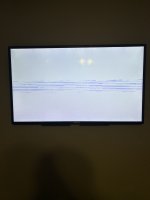Hello everyone,
First time poster here. I decided to make this post since I am having issues with my Wii U. Currently, my Wii U will not boot up to the main menu. It stays stuck on the Wii U logo indefinitely.
There are a few things to note about my console. The console is the black 32 gb model. I believe it was bought during the 2012 holiday season (release) as we were expecting to play Pikmin 3 before it got delayed. The system has never been modded in any fashion. It was not the most heavily played console, and I can't even give a good estimate of when it was last used (at least more than 3 years).
I have already tried doing the UDPIH, however it does not seem to be working. When using the second recovery menu, I get a white screen with some blue lines (see attached image). I believe this is similar to what @fadafwet described in his post. I was able to get the logs from the system, which I have attached to this post. Any idea what the issue may be and how to fix it? Any help would be much appreciated.
First time poster here. I decided to make this post since I am having issues with my Wii U. Currently, my Wii U will not boot up to the main menu. It stays stuck on the Wii U logo indefinitely.
There are a few things to note about my console. The console is the black 32 gb model. I believe it was bought during the 2012 holiday season (release) as we were expecting to play Pikmin 3 before it got delayed. The system has never been modded in any fashion. It was not the most heavily played console, and I can't even give a good estimate of when it was last used (at least more than 3 years).
I have already tried doing the UDPIH, however it does not seem to be working. When using the second recovery menu, I get a white screen with some blue lines (see attached image). I believe this is similar to what @fadafwet described in his post. I was able to get the logs from the system, which I have attached to this post. Any idea what the issue may be and how to fix it? Any help would be much appreciated.




